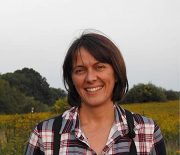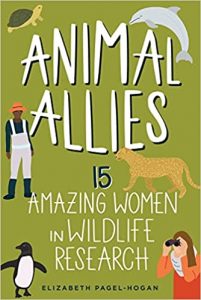On Writing Animal Allies: 15 Amazing Women in Wildlife Research
 Animal Allies: 15 Amazing Women in Wildlife Research
Animal Allies: 15 Amazing Women in Wildlife Research
Elizabeth Pagel-Hogan
Chicago Review Press, 2022
When I started to work on Animal Allies, I looked for people working with known and unknown animals. There are birds, arthropods, sea creatures, reptiles and amphibians, and mammals.
It was hard to only pick 15 animals though. I love animals. I’ve had all kinds of pets throughout my life.
Every chapter includes each scientist’s social media information because a big theme of this book is that they are all dedicated to science communication. They work hard to share their research and involve the general public, largely to protect and conserve the animals they research. They aren’t doing research in the old “ivory tower” that limits who has access to knowledge. They share their work and ideas and knowledge with the goal of involving and engaging everyone.
Dealing with racism and harassment was as much a part of their experience as taking tests, doing fieldwork, and publishing their research. I want future scientists, of any identity, to know about these things and be ready to be anti-racist and anti-sexist. We need to talk about these problematic behaviors, learn how to recognize them, and be ready to challenge and change them.
Every single one of the scientists amazed me with their generosity. They took time from their day to share their stories, their trials and achievements, with the main goal of informing the world about the need to take action to protect animals. They also share their work to inspire others to follow their curiosity and passion. They aren’t doing research in the old “ivory tower” that limits who has access to knowledge. They share their work and ideas and knowledge with the goal of involving and engaging everyone.
As a writer, I like to know my general path but I welcome the serendipitous discoveries along the way. So, for this particular book, I had a narrative structure for each chapter that I had developed based around a consistent set of questions. But I always made room for the unique and surprising stories these scientists shared with me.
Excerpt:
The sharp grasses growing in the salt marshes off the coast of Georgia make it a dangerous place to work.
“The marsh has drawn blood,” says Corina Newsome. “It’s drawn blood, sweat, and tears.”
Corina Newsome is a birder, a Black woman, an activist, and a scientist. She is a researcher working on her master’s degree in biology from Georgia Southern University and has spent weeks in the salt marshes off the Georgia coast.
“It smells like a mix between salt and wet dirt,” Corina says. In her knee-high wading boots, tank top, and a visor—no hat could contain her braids—she has braved the challenges of the marsh.
“Walking in mud is like walking up stairs the entire time. The first time I went out I was utterly exhausted within 30 minutes,” she says.
The marsh is no easy place to study. Before arriving there, she had to get through strips of grass filled with grasshoppers—it seemed like thousands of them. The shrieks and calls of large wading birds like herons and egrets startled her.
“Their calls are terrifying, like dinosaurs. One time I didn’t know a tricolored heron was there. It called, and I thought it was a man chasing me. I screamed and ran,” she says.
And then there are the sharks.
“I was taking a rest and had my foot in a tidal river, and a dogfish shark swam over my foot. I was stunned,” she says.
The marsh isn’t just a dangerous place to study; it can be a dangerous place to live, especially for the Seaside Sparrow.
Corina is researching the Seaside Sparrow. It’s a tiny grey and brown bird with a flashy yellow patch on its face. It makes its home in the grasses of the salt marsh. The Seaside Sparrow is found along the East Coast of the United States and down to parts of the Gulf Coast. This bird doesn’t—and can’t—live anywhere else. The female weaves an open cup nest suspended above the ground in the cordgrass. She lays between two and six white, speckled eggs. When they hatch, both the male and female feed the hatchlings. The young birds leave the nest soon after hatching, around 12 days, if they survive that long.
Sometimes, an unusually high tide causes the eggs and chicks to drown if they are too close to the ground. It’s a risk all Seaside Sparrows face. But if the sparrows build their nests higher to keep them from flooding again, there are other threats. Predators, including raccoons, mink, and the local rice rat, all stalk the grasses, hunting for the nests. They are easier to find if they are high off the ground. So the sparrows have to build their nests in a perfect place, not too low, where they’ll get flooded, and not so high that predators can see them.
Unfortunately, the perfect nest placement will get harder to find. Climate change is causing sea levels to rise. For example, seas have risen seven inches (18 cm) on the coast of Georgia. Tides are coming in higher in the marsh, causing bird nests to fail, and scientists think this will make it harder for them to balance the threat of flooding and the threat of predators.
The birds are stuck between a rock and a hard place.
During her research, Corina set up video cameras to watch the nests. She had videos of eggs hatching, parents feeding, the wind shaking the grasses that hold the sturdy structures.
She also set up camera traps in the nearby area. Camera traps are motion-triggered. They turn on when something moves by them, like a hungry raccoon or rice rat.
Sometimes the videos were difficult to watch. Corina has observed the struggles of sparrows. She’s seen rice rats take chicks. And she’s watched new dangers arrive. Rising water lev- els flood more nests and bring new predators, like fish, to prey on chicks. One loss of a chick caught on video was especially hard for her.
“I cried. My heart was broken,” says Corina. “These birds are declining in number.
Every nesting success for these birds means so much. I imagined what that chick was feeling, but also thought about the larger population. Because of climate change, nest flooding will keep happening. Chicks are going to drown. Plus, now there are new predators.”
Despite her heartbreak, Corina knew this video was important.
“No one would have know it happened without the scientists doing this research. I felt honored to offer this perspective. I did the work to get this up-close look to provide important info about protecting them. It gave me purpose.”
—
Elizabeth Pagel-Hogan is a children’s author and teacher from Pittsburgh, PA.
She is the author of The Science and Technology of Leonardo da Vinci (2021) and a dozen fiction and nonfiction books and graphic novels. She’s also written for textbooks and online educational resources. She writes fiction, non-fiction, crafts, and recipes for magazines including Highlights for Children, Spider, and Muse.
She is the Regional Advisor for SCBWI Pennsylvania: West. She was the 2016-2017 Pen Parentis Fellow and won an SCBWI Merit Award in 2020.
Elizabeth lives with her family and pet schnoodle. She loves board games, birding, and baking. She’s a lifelong runner and avid community scientist. Her kids say she has a loud laugh.
Animal Allies: 15 Amazing Women in Wildlife Research
 These 15 women work with animals on land, air, and sea.
These 15 women work with animals on land, air, and sea.
Corina Newsome is saving seaside sparrows while Michelle LaRue uses satellites to study Antarctic birds. Lizzy Lowe takes on what many fear in researching spiders, and Erin Ashe lives out the dream of many studying dolphins and whales. Kristen Hecht chases the elusive hellbender amphibian while Enikö Kubinyi uses robots to get information on wolf pups.
These women are working on issues that intersect with biodiversity, species conservation, biology, and more. They stand out for their work in their fields and are also dedicated to science communication to share their knowledge with others. They challenge the assumptions of who a scientist is and what a scientist looks like.
These diverse, modern women are pushing the boundaries of their scientific fields while empowering others to pursue their dreams.
BUY HERE
Category: How To and Tips, On Writing























